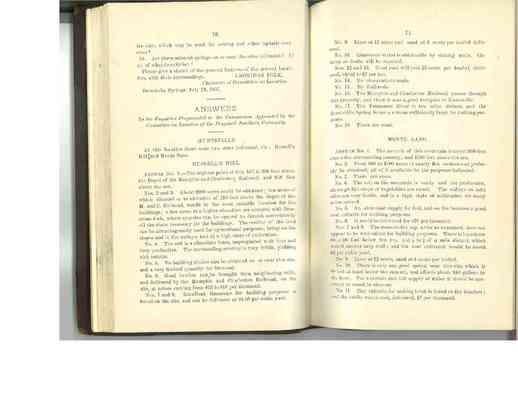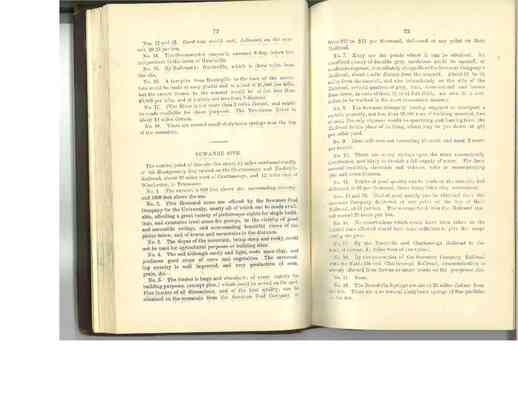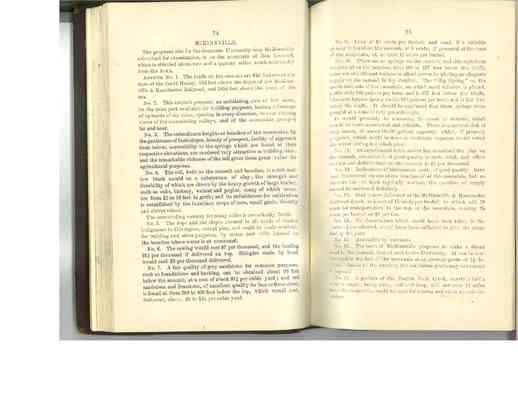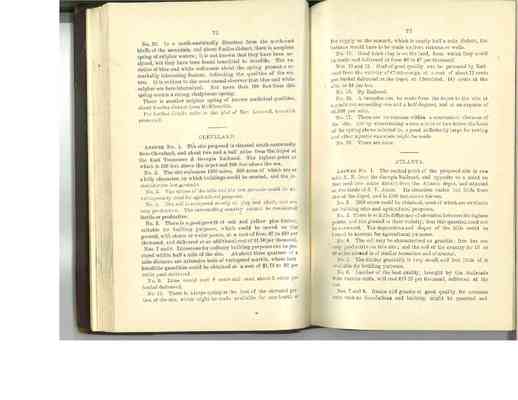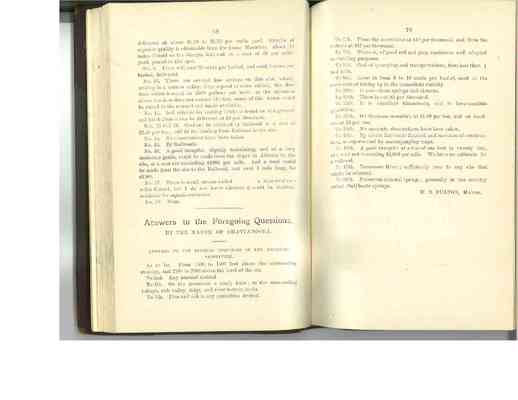Pages
36
70.
ive sites, which may be used for rowing and other aquatic exercises? 18. Are there mineral springs on or near the sites indicated? If so, of what description? Please give a sketch of the general features of the several localities, with their surroundings. LEONIDAS POLK, Chairman of Committee on Location. Beersheba Springs, July 24, 1857.
______
ANSWERS To the Enquiries Propounded to the Commission Appointed by the Committee on Location of the Proposed Southern Univeristy.
---------
HUNTSVILLE.
At this location there were two sites indicated, viz: Russell's Hill and Monte Sano. RUSSELL'S HILL. ANSWER No. 1. -- The highest point of the hill is 208 feet above the Depot of the Memphis and Charleston Railroad, and 818 Feet above the sea. Nos. 2 and 3. About 2000 acres could be obtained; then acres of which, situatied at an elevation of 116 feet above the depot of the M. And C. Railroad, would be he most suitable location for the buildings; a few acres at a higher elevation are covered with limestone rock, where quarries can be opened to furnish conveniently all the stone necessary for the fuildings. The residue of the land can be advantageously used for agricultural purposes, being on the slopes and in the valleys, and in a high state of cultivation. No. 4. The soil is a chocolate loam, impregnated with lime and very productive. The surrounding country is very fertile, yielding rich returns. No. 5. No building timber can be obtained on or near this site, and very limited quantity for firewood. No. 6. Good lumber can be brought from neighboring mills, and deliverd by the Memphis and Charleston Railroad, on the site, at prices varying from $15 to $18 per thousand. Nos. 7 and 8. Excellent limestone for building purposes is found on the site, and can be delivered at $1.50 per cubic yard.
71
No. 9. Lime at 12 cents and sand at 6 cents per bushel delivered. No. 10. Limestone water is obtainable by sinking wells. Cisterns no doubt will be required. Nos. 12 and 13. Good coal will cost 25 cents per busheel, delivered, equal to $7 per ton. No. 14. No observations made. No. 15. By Railroads. No. 16. The Memphis and Charleston Railroad passes through this property, and there is also a good turnpike to Huntsville. No. 17. The Tennessee River is ten miles distant, and the Huntsville Spring forms a stream sufficiently large for bathing purposes. No. 18. There are none.
MONTE SANO.
ANSWER No. 1. The summit of this mountain is about 900 feet above the surrounding country, and 1500 feet above the sea. No. 2. From 800 to 1000 acresof nearly flat surface can probably be obtained, all of it available for the purposes indicated. No. 3. There are none. No 4. The soil on the mountain is sandy and not productive, although fair crops of vegetables are raised. The valleys on both sides are very fertile, and in a high state of cultivation for many miles around. No. 5. An abundant supply for fuel, and on the benches a good deal suitable for building purposes. No. 6. It could be delivered for $20 per thousand. Nos. 7 and 8. The stone of the top, as far as examined, does not appear to be well suited for building purposes. There is limestone 80 or 90 feet below the top, and 1/2 to 3/4 of a mile distant, which would answer very well; and the cost delivered would be about $2 per cubic yard. No. 9. Lime at 12 cents, sand at 4 cents per bushel. No. 10. There is only one good spring near this site, which is 80 feet as least below the summit, and affords about 240 gallons to the hour. For a certain and full supply of water it would be neccessary to resort to cisterns. No. 11. Clay suitable for making brick is found on the benches; and the bricks would cost, delivered, $7 per thousand.
37
72
Nos. 12 and 13. Good coal would cost, delivered on the summit, $9.25 per ton. No. 14. The thermometer ranges in summer 6 deg. below the temperature in the town of Huntsville. No. 15. By Railroad to Huntsville, which is three miles from the site. No. 16. A turnpike from Huntsqille to the base of the mountain could be made at easy grades and at a cost of $1,800 per mile, but the ascent thence to the summit would be at not less than $3,000 per mile, and at a grade not less than 5 degrees. No. 17. Flint River is not more than 3 miles distant, and might be made available for these purposes. The Tennessee River is about 12 miles distant. No. 18. There are several small chalybeate springs near the top of the mountain.
-------------------
SEWANEE SITE.
The central point of this site lies about 5 1/2 miles northeastwardly of the Montgomery Gap tunnel on the Chattanooga and Nashville Railroad, about 62 miles west of Chattanooga, and 12 miles east of Winchester, in Tennessee. No. 1. The summit is 850 feet above the surrounding country, and 1938 feet above the sea. No. 2. Five thousand acres are offered by the Sewanee Coal Company for the University, nearly all of which can be made available, affording a great variety of picturesque sights for the single buildings, and extensive level areas for groups, in the vicinity of good and accessible springs, and commanding beautiful views of the plains below, and of towns and mountains in the distance. No. 3. The slopes of the mountain, being steep and rocky, could not be used for agricultural purposes or building sites. No. 4. The soil although sandy and light, rests upon clay, and produces good crops of corn and vegetables. The surrounding country is well improved, and very productive of corn, grain, &e. No. 5. The timber is large and abundant; of every variety for building purposes, (except pine,) which could be sawed on the spot. Pine lumber of all dimensions, and of the best quality, can be obtained on the mountain from the Sewanee Coal Company, at
73
from $12 to $15 per thousand, delivered at any point on their Railroad. No. 7. Many are the points where it can be obtained. An excellent quarry of durable grey sandstone could be opened, at moderate expense, immediatly alongside of the Sewanee Company's Railroad, about a mile distant from the summit. About 2 1/2 to 4 1/2 miles from the summit, and also immediatly on the side of the Railroad, several quarries of grey, blne, dove-colored and brown lime stone, in beds of from 2 1/2 to 4 1/2 feet thick, are now in a condition to be worked in the most economical manner. No. 8. The Sewanee Company having engaged to transport a certain quantity, not less than 20,000 tons of building material, free of cost, the only expense would be quarrying and hauling from the Railroad to the place of building, which may be put down at $1 1/2 per cubic yard. No. 9. Lime will cost not exceeding 10 cents, and sand 2 cents per bushel. No. 10. There are many springs upon the tract conveniently distributed, and likely to furnish a full supply of water. For their several localities, elevation and volume, refer to accompanying plat and notes thereon. No. 11. Bricks of good quality can be made on the summit, and delivered at $6 per thousand, there being brick clay convenient. Nos. 12. and 13. Coal of good quality can be obtained from the Sewanee Company, delivered at any point on the line of their Railroad, at $4 per ton. The average haul from the Railroad cannot exceed 20 cents per ton. No. 14. No observations which could have been taken in the limited time allowed would have been sufficient to give the range during the year. No. 15. By the Nashville and Chattanooga Railroad to the town of Cowan, 1 1/2 miles west of the tunnel. No. 16. By the connection of the Sewanee Company Railroad with the Nashville and Chattanooga Railroad, communication is already effected from Cowan to many points on the proposed site. No. 17. None. No. 18. The Bersheba Springs are about 30 miles distant from the site. There are also several chalybeate springs of ine qualities on the site.
38
74
MCMINNVILLE.
The proposed site for the Southern University near McMinnville submitted for examination, is on the mountain of Ben Lomond, which is situated about two and a quarter miles south-eastwardly from the town.
ANSWER No. 1 The bluffs on the summit are 842 feet above the base of the Court House; 916 feet above the depot of the McMinnville & Manchester Railroad, and 1854 feet above the level of the sea.
No. 2. This summit presents an undulating area of 508 acres, for the most part available for building purposes, having a frontage of upwards of six miles, opening in every direction, to ever varying views of the surrounding valleys, and of the mountains grouped far and near.
No. 3. The subordinate heights or benches of the mountains, by the gentleness of their slopes, beauty of prospect, facility of approach from below, accessibility to the springs which are found at their respective elevations, are rendered very attractive as building sites; and the remarkable richness of the soil gives them great value for agricultural purposes.
No. 4. The soil, both on the summit and benches, is a rich mellow black mould on a substratum of clay; the strength and durability of which are shown by the heavy growth of large timber, such as oaks, hickory, walnut and poplar, many of which measure from 12 to 16 feet in girth; and its suitableness for cultivation is established by the luxuriant crops of corn, small grain, timothy and clover raised.
The surrounding country for many miles is remarkably fertile.
No. 5. The tops and the slopes abound in all kinds of timber indigenous to this region, except pine, and could be made available for building and other purposes, by steam saw mills located on the benches where water is at command.
No. 6. The sawing would cost $7 per thousand, and the hauling $1 1/2 per thousand if delivered on top. Shingles made by hand would cost $3 per thousand delivered.
No. 7. A fair quality of grey sandstone for common purposes, such as foundations and backing, can be obtained about 20 feet below the summit, at a cost of about $1 1/4 per cubic yard; and red sandstone and limestone, of excellent quality for face or front stone, is found at from 200 to 400 feet below the top, which would cost, delivered, about, $2 to $2 1/2 per cubic yard.
75
No. 9. Lime at 10 cents per bushel, and sand, if a suitable quality is found on the summit, at 5 cents; if procured at the base of the mountain, at, at least 12 cents per bushel.
No. 10. There are no springs on the summit, and although there are several on the benches, from 100 to 437 feet below the bluffs, none are of sufficient volume to afford power for placing an adequate supply on the summit in dry weather. The "Big Spring" on the north-east side of the mountain, on which most reliance is placed, yields only 280 gallons per hour, and is 437 feet below the bluffs. The next largest spring yields 180 gallons per hour, and is 312 feet below the bluffs. It should be explained that these springs were gauged at the time of very great drought.
It would probably be necessary to resort to cisterns, which would be more economical and reliable. There is a natural sink of easy access, of about 20,000 gallons capacity, which, if properly prepared, which could be done at moderate expense, would retain the water during the whole year.
No. 11. An experienced brick-maker has examined the clay on the summit, considers it of good quality to make brick, and offers to barn and deliver them on the summit at $5 per thousand.
No. 12. Indications of bituminous coal, of good quality, have been discovered on one of the benches of of this mountain, but as the vein has not been regularly worked, the question of supply cannot be answered definitely.
No. 13. Coal is now delivered at the McMinnville & Manchester Railroad depot, at a cost of 15 cents per bushel, to which add 10 cents for transportation to the top of the mountain, making 25 cents per bushel, or $7 per ton.
No. 14. No observations which could have been taken in the limited time allowed, would have been sufficient to give the range during the year.
No. 15. Accessible by railroads.
No. 16. The town of McMinnville proposes to make a direct road to the summit, free of cost to the University. It can be constructed to the foot of the mountain at an average grade of 1 1/4 degrees; thence to the summit, the maximum grade may not exceed 6 degrees.
No. 17. A portion of the Barren Fork Creek, nearly a half a mile in length, being wide, still and deep, and not over 1 1/2 miles from the mountain, could be used for rowing and other aquatic exercises.
39
76
No. 18. In a north-eastwardly direction from the north-east bluffs of the mountain, and about 2 miles distant, there is a copious spring of sulphur waters; it is not known that they have been analyzed, but they have been found beneficial to invalids. The varieties of blue and white sediments about the spring present a remarkably interesting feature, indicating the qualities of the waters. It is evident to the most casual observer that blue and white sulphur are here intermixed. Not more than 100 feet from this spring occurs a strong chalybeate spring.
There is another sulphur spring of known medicinal qualities, about 6 miles distant from McMinnville.
For further details refer to the plot of Ben Lomond, herewith presented.
---------
CLEVELAND.
ANSWER No. 1. The site proposed is situated south-eastwardly from Cleveland, and about two and a half miles from the depot of the East Tennessee & Georgia Railroad. The highest point of which is 120 feet above the depot and 998 feet above the sea.
No. 2. The site embraces 1200 acres, 500 acres of which are of a hilly character, on which buildings could be erected, and the remainder are low grounds.
No. 3. The slopes of the hills and the low grounds could be advantageously used for agricultural purposes.
No. 4. The soil is composed mostly of clay and chert, and not very productive. The surrounding country cannot be considered fertile or productive.
No. 5. There is a good growth of oak and yellow pine timber, suitable for building purposes, which could be sawed on the ground, with steam or water power, at a cost of from $7 to $10 per thousand, and delivered at an additional cost of $1.50 per thousand.
Nos. 7 and 8. Limestone for ordinary building purposes can be procured within half a mile of the site. At about three quarters of a mile distance are extensive beds of variegated marble, where inex haustible quantities could be obtained at a cost of $1.75 to $2 per cubic yard delivered.
No. 9. Lime would cost 8 cents and sand about 3 cents per bushel delivered.
No. 10. There is a large spring at the foot of the elevated portion of the site, which might be made available for one-fourth of
77
the supply on the summit, which is nearly half a mile distant, the balance would have to be made up from cisterns or wells.
No. 11. Good brick clay is on the land, from which they could be made and delivered at from $6 to $7 per thousand.
Nos. 12 and 13. Coal of good quality can be procured by Railroad from the vicinity of Chattanooga, at a cost of about 12 cents per bushel delivered at the depot at Cleveland, 14 1/2 cents at the site, or $4 per ton.
No. 15. By Railroad.
No. 16. A turnpike can be made from the depot to the site at a grade not exceeding one and a half degrees, and at an expense of $1,500 per mile.
No. 17. There are no streams within a convenient distance of the site, but by constructing a dam a mile or two below the head of the spring above referred to, a pond sufficiently large for rowing and other aquatic exercises might be made.
No. 18. There are none.
-----------
ATLANTA.
ANSWER No. 1. The central point of the proposed site is one mile N. E. from the Georgia Railroad, and opposite to a point on that road two miles distant from the Atlanta depot, and situated on the lands of J. V. Jones. Its eleuation varies, but little from that of the depot, and is 1050 feet above the sea.
No. 2. 1000 acres can be obtained, most of which are available for building sites and agricultural purposes.
No. 3. There is so little difference of elevation between the highest points, and the ground in their vicinity, that this question need not be answered. The depressions and slopes of the hills could be turned to account for agricultural purposes.
No. 4. The soil may be characterised as granitic; free but not very productive on this site; and the soil of the country for 15 or 20 miles around is of similar formation and character.
No. 5. The timber generally is very small, and but little of it available for building purposes.
No. 6. Lumber of the best quality, brought by the Railroads from various mills, will cost $13 25 per thousand, delivered at the site.
Nos. 7 and 8. Gneiss and granite of good quality for common uses, such as foundations and backing, might be quarried and
40
{left page} 78
delivered at about $1.50 to $1.75 per cubic yard. Granite of superior quality is obtainable from Stone Mountain, about 15 miles distant on the Georgia Railroad, at a cost of $3 per cubic yard, placed on the spot.
No. 9. Lime will cost 33 cents per bushel, and sand 4 cents per bushel, delivered.
No. 10. There are several fine springs on the site, which, uniting in a narrow valley, form a pond of some extent, the flow from which is equal to 2500 gallons per hour; as the elevation above the dam does not exceed 110 feet, much of this water could be raised to the summit and made available.
No.11. Soil suitable for making bricks is found on the ground, and brick from it can be delivered at $6 per thousand.
Nos. 12 and 13. Coal can be obtained by Railroad at a cost of $2.50 per ton; add $1 for hauling from the Railroad to the site.]
No. 14. No observations have been taken.
No. 15. By Railroads.
No. 16. A good turnpike, slightly undulating, and at a very moderate grade, could be made from the depot at Atlanta to the site, at a cost not exceeding $1800 per mile. And a road could be made from the site to the Railroad, not over 1 mile long, $1500.
No. 17. There is small stream called {blank} a little over two miles distant, but I do not know whether it could be rendered available for aquatic exercises.
No. 18. None.
Answers to the Foregoing Questions, BY THE MAYOR OF CHATTANOOGA.
ANSWERS TOT EH SEVERAL INQUIRITES OF THE LOCATING COMMITTEE.
As to 1st. From 1300 to 1500 feet above the surrounding country, and 2100 to 2300 above the level of the sea.
To 2nd. Any amount desired.
To 4th. On the mountain a sandy loam; in the surrounding valleys, rich valley, ridge, and river bottom lands.
To 5th. Pine and oak in any quantities desired.
{right page}
79
To 6th. From the mountains at $10 per thousand, and from the valleys at $16 per thousand.
To 7th. There is, of good red and grey sandstone, well adapted to building purposes.
To 8th. Cost of quarrying and transportations, from less that ¼ to 1 mile.
To 9th. Lime at from 8 to 10 cents per bushel, sand at the mere cost of taking up in the immediate vicinity.
To 10th. It can—from springs and cisterns.
To 11th. There is—at $5 per thousand.
To 12th. It is excellent bituminous, and in inexhaustible quantities.
To 13th. On Raccoon mountain at $1.80 per ton, and on Lookout at $6 per ton.
To 14th. No accurate observations have been taken.
To 15th. By divers Railroad finished and in course of construction, as represented by accompanying maps.
To 16th. A good turnpike at a rise of one foot in twenty feet, at a cost not exceeding $2,000 per mile. We have no estimate for a railroad.
To 17th. Tennessee River; sufficiently near to any site that might be selected.
To 18th. Numerous mineral springs; generally in the country called chalybeate springs.
W. D. FULTON, MAYOR.
